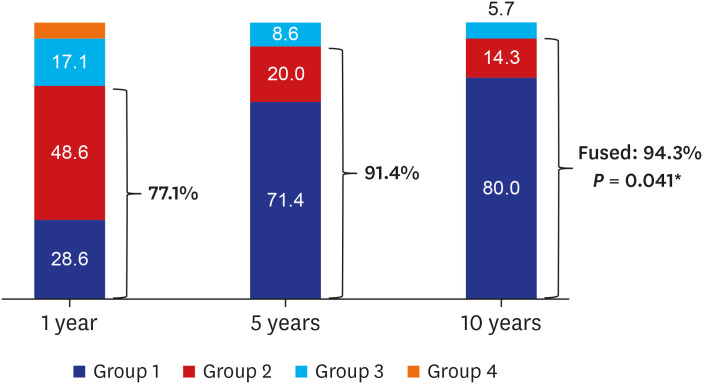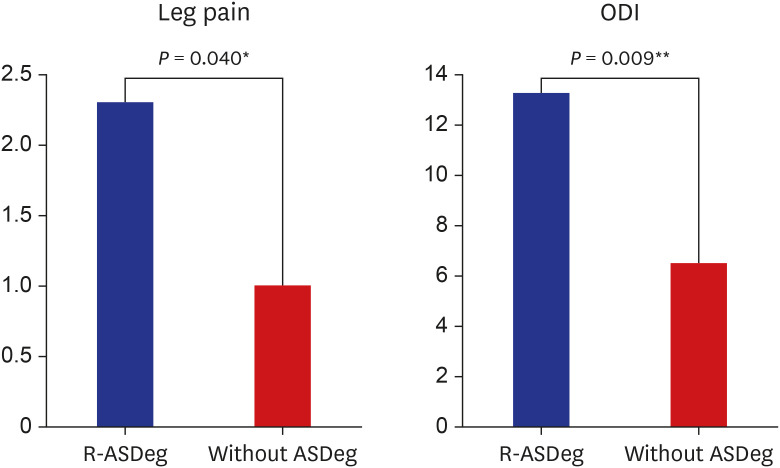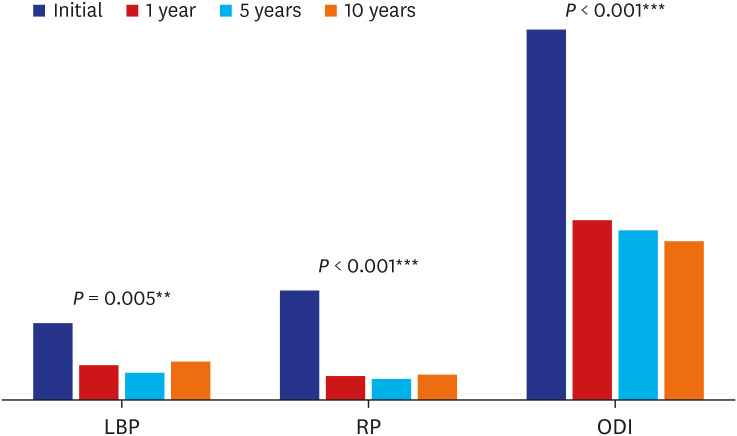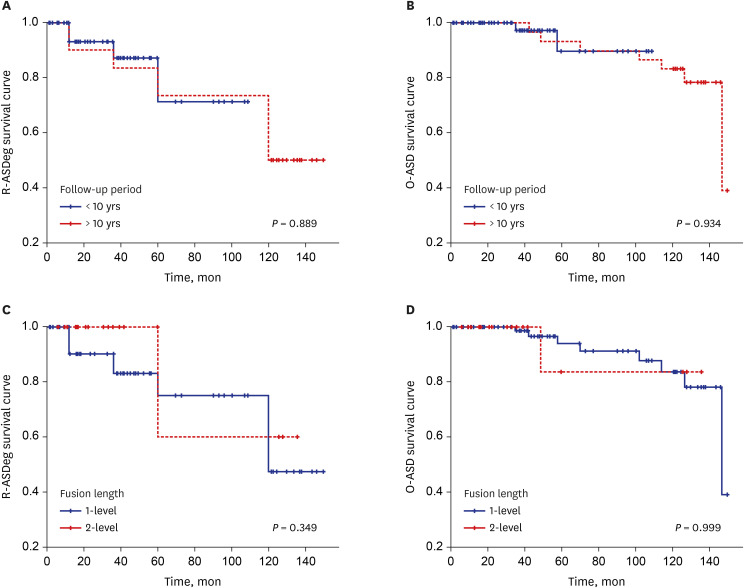J Korean Med Sci.
2022 Apr;37(13):e105. 10.3346/jkms.2022.37.e105.
Long-Term Clinical and Radiological Outcomes of Minimally Invasive Transforaminal Lumbar Interbody Fusion: 10-Year Follow-up Results
- Affiliations
-
- 1Department of Orthopaedic Surgery, Jeju National University Hospital, Jeju, Korea
- 2Department of Orthopaedic Surgery, Soonchunhyang University Seoul Hospital, Seoul, Korea
- 3Department of Orthopaedic Surgery, Soonchunhyang University Cheonan Hospital, Cheonan, Korea
- KMID: 2527833
- DOI: http://doi.org/10.3346/jkms.2022.37.e105
Abstract
- Background
Many studies have reported that minimally invasive transforaminal lumbar interbody fusion (MI-TLIF) provides satisfactory treatment comparable to other fusion methods. However, in the case of MI-TLIF, there are concerns about the long-term outcome compared to conventional bilateral PLIF due to the small amount of disc removal and the lack of autogenous bone graft. Long-term follow-up studies are still lacking as most of the previous reports have follow-up periods of up to 5 years.
Methods
Thirty patients who underwent MI-TLIF were followed up for > 10 years (mean, 11.1 years). Interbody fusion rates were determined using a modified Bridwell grading system. Adjacent segment disease (ASD) was defined as radiological adjacent segment degeneration (R-ASDeg) as seen on plain X-rays; reoperated adjacent segment disease referred to the subsequent need for revision surgery. Clinical outcomes after surgery were assessed based on back and leg pain as well as the Oswestry disability index (ODI).
Results
The overall radiological fusion rate, at the 1-, 5-, and 10-year follow-up was 77.1%, 91.4%, and 94.3%, respectively. The incidence of R-ASDeg 1, 5, and 10 years after surgery was 6.7%, 16.7%, and 43.3% at the proximal adjacent segment and 4.8%, 14.3%, and 28.6% at the distal adjacent segment, respectively. R-ASDeg at either the proximal or distal segment was determined in 50.0% of the patients 10 years postoperatively. All clinical parameters improved significantly during follow-up, although the ODI and the visual analog scale (VAS) for leg pain at the 10-year follow-up were significantly worse in the R-ASDeg group than in the other patients (P = 0.009, P = 0.040).
Conclusion
MI-TLIF improved both clinical and radiological outcomes, and the improvements were maintained for up to 10 years after surgery. However, R-ASDeg developed in up to 50% of the patients within 10 years, and both leg pain on the VAS and the ODI were worse in patients with R-ASDeg.
Keyword
Figure
Reference
-
1. Lee BH, Moon SH, Suk KS, Kim HS, Yang JH, Lee HM. Lumbar spinal stenosis: pathophysiology and treatment principle: a narrative review. Asian Spine J. 2020; 14(5):682–693. PMID: 33108834.
Article2. Park Y, Ha JW. Comparison of one-level posterior lumbar interbody fusion performed with a minimally invasive approach or a traditional open approach. Spine (Phila Pa 1976). 2007; 32(5):537–543. PMID: 17334287.
Article3. Ntoukas V, Müller A. Minimally invasive approach versus traditional open approach for one level posterior lumbar interbody fusion. Minim Invasive Neurosurg. 2010; 53(1):21–24. PMID: 20376740.
Article4. Kim YH, Ha KY, Rhyu KW, Park HY, Cho CH, Kim HC, et al. Lumbar interbody fusion: techniques, pearls and pitfalls. Asian Spine J. 2020; 14(5):730–741. PMID: 33108838.
Article5. Harms J, Jeszenszky D. The unilateral transforaminal approach for posterior lumbar interbody fusion. Orthop Traumatol. 1998; 6:88–99.6. Humphreys SC, Hodges SD, Patwardhan AG, Eck JC, Murphy RB, Covington LA. Comparison of posterior and transforaminal approaches to lumbar interbody fusion. Spine (Phila Pa 1976). 2001; 26(5):567–571. PMID: 11242386.
Article7. Foley KT, Holly LT, Schwender JD. Minimally invasive lumbar fusion. Spine (Phila Pa 1976). 2003; 28(15):Suppl. S26–S35. PMID: 12897471.
Article8. Hee HT, Castro FP Jr, Majd ME, Holt RT, Myers L. Anterior/posterior lumbar fusion versus transforaminal lumbar interbody fusion: analysis of complications and predictive factors. J Spinal Disord. 2001; 14(6):533–540. PMID: 11723406.
Article9. Brodke DS, Dick JC, Kunz DN, McCabe R, Zdeblick TA. Posterior lumbar interbody fusion. A biomechanical comparison, including a new threaded cage. Spine (Phila Pa 1976). 1997; 22(1):26–31. PMID: 9122778.10. Miyakoshi N, Abe E, Shimada Y, Okuyama K, Suzuki T, Sato K. Outcome of one-level posterior lumbar interbody fusion for spondylolisthesis and postoperative intervertebral disc degeneration adjacent to the fusion. Spine (Phila Pa 1976). 2000; 25(14):1837–1842. PMID: 10888954.
Article11. Ringel F, Stoffel M, Stüer C, Meyer B. Minimally invasive transmuscular pedicle screw fixation of the thoracic and lumbar spine. Neurosurgery. 2006; 59(4):Suppl 2. ONS361–ONS366. PMID: 17041505.
Article12. Schwender JD, Holly LT, Rouben DP, Foley KT. Minimally invasive transforaminal lumbar interbody fusion (TLIF): technical feasibility and initial results. J Spinal Disord Tech. 2005; 18(Suppl):S1–S6. PMID: 15699793.13. Park J, Ham DW, Kwon BT, Park SM, Kim HJ, Yeom JS. Minimally invasive spine surgery: techniques, technologies, and indications. Asian Spine J. 2020; 14(5):694–701. PMID: 33108835.
Article14. Peng CW, Yue WM, Poh SY, Yeo W, Tan SB. Clinical and radiological outcomes of minimally invasive versus open transforaminal lumbar interbody fusion. Spine (Phila Pa 1976). 2009; 34(13):1385–1389. PMID: 19478658.
Article15. Scheufler KM, Dohmen H, Vougioukas VI. Percutaneous transforaminal lumbar interbody fusion for the treatment of degenerative lumbar instability. Neurosurgery. 2007; 60(4):Suppl 2. 203–212. PMID: 17415155.
Article16. Schizas C, Tzinieris N, Tsiridis E, Kosmopoulos V. Minimally invasive versus open transforaminal lumbar interbody fusion: evaluating initial experience. Int Orthop. 2009; 33(6):1683–1688. PMID: 19023571.
Article17. Chang HK, Huang M, Wu JC, Huang WC, Wang MY. Less opioid consumption with enhanced recovery after surgery transforaminal lumbar interbody fusion (TLIF): a comparison to standard minimally-invasive TLIF. Neurospine. 2020; 17(1):228–236. PMID: 32252173.
Article18. Park P, Foley KT. Minimally invasive transforaminal lumbar interbody fusion with reduction of spondylolisthesis: technique and outcomes after a minimum of 2 years’ follow-up. Neurosurg Focus. 2008; 25(2):E16.
Article19. Park Y, Ha JW, Lee YT, Sung NY. The effect of a radiographic solid fusion on clinical outcomes after minimally invasive transforaminal lumbar interbody fusion. Spine J. 2011; 11(3):205–212. PMID: 21377602.
Article20. Jenkins NW, Parrish JM, Hrynewycz NM, Brundage TS, Singh K. Longitudinal evaluation of patient-reported outcomes measurement information system for back and leg pain in minimally invasive transforaminal lumbar interbody fusion. Neurospine. 2020; 17(4):862–870. PMID: 33401864.
Article21. Chen BL, Wei FX, Ueyama K, Xie DH, Sannohe A, Liu SY. Adjacent segment degeneration after single-segment PLIF: the risk factor for degeneration and its impact on clinical outcomes. Eur Spine J. 2011; 20(11):1946–1950. PMID: 21720728.
Article22. Landis JR, Koch GG. The measurement of observer agreement for categorical data. Biometrics. 1977; 33(1):159–174. PMID: 843571.
Article23. Pfirrmann CW, Metzdorf A, Zanetti M, Hodler J, Boos N. Magnetic resonance classification of lumbar intervertebral disc degeneration. Spine (Phila Pa 1976). 2001; 26(17):1873–1878. PMID: 11568697.
Article24. Imagama S, Kawakami N, Matsubara Y, Kanemura T, Tsuji T, Ohara T. Preventive effect of artificial ligamentous stabilization on the upper adjacent segment impairment following posterior lumbar interbody fusion. Spine (Phila Pa 1976). 2009; 34(25):2775–2781. PMID: 19940736.
Article25. Okuda S, Nagamoto Y, Matsumoto T, Sugiura T, Takahashi Y, Iwasaki M. Adjacent segment disease after single segment posterior lumbar interbody fusion for degenerative spondylolisthesis: minimum 10 years follow-up. Spine (Phila Pa 1976). 2018; 43(23):E1384–E1388. PMID: 29794583.26. Kim JS, Jung B, Lee SH. Instrumented minimally invasive spinal-transforaminal lumbar interbody fusion (MIS-TLIF): minimum 5-year follow-up with clinical and radiologic outcomes. Clin Spine Surg. 2018; 31(6):E302–E309. PMID: 23027364.27. Park Y, Ha JW, Lee YT, Sung NY. Minimally invasive transforaminal lumbar interbody fusion for spondylolisthesis and degenerative spondylosis: 5-year results. Clin Orthop Relat Res. 2014; 472(6):1813–1823. PMID: 23955260.
Article28. Bin Abd Razak HR, Dhoke P, Tay KS, Yeo W, Yue WM. Single-level minimally invasive transforaminal lumbar interbody fusion provides sustained improvements in clinical and radiological outcomes up to 5 years postoperatively in patients with neurogenic symptoms secondary to spondylolisthesis. Asian Spine J. 2017; 11(2):204–212. PMID: 28443164.
Article29. Min JH, Jang JS, Lee SH. Comparison of anterior- and posterior-approach instrumented lumbar interbody fusion for spondylolisthesis. J Neurosurg Spine. 2007; 7(1):21–26. PMID: 17633483.
Article30. Nakai S, Yoshizawa H, Kobayashi S. Long-term follow-up study of posterior lumbar interbody fusion. J Spinal Disord. 1999; 12(4):293–299. PMID: 10451044.
Article31. Ha DH, Kim TK, Oh SK, Cho HG, Kim KR, Shim DM. Shim D-MJCiOS. Results of decompression alone in patients with lumbar spinal stenosis and degenerative spondylolisthesis: a minimum 5-year follow-up. Clin Orthop Surg. 2020; 12(2):187–193. PMID: 32489540.
Article32. Lee JC, Kim Y, Soh JW, Shin BJ. Risk factors of adjacent segment disease requiring surgery after lumbar spinal fusion: comparison of posterior lumbar interbody fusion and posterolateral fusion. Spine (Phila Pa 1976). 2014; 39(5):E339–E345. PMID: 24365899.33. Kim KH, Lee SH, Shim CS, Lee DY, Park HS, Pan WJ, et al. Adjacent segment disease after interbody fusion and pedicle screw fixations for isolated L4-L5 spondylolisthesis: a minimum five-year follow-up. Spine (Phila Pa 1976). 2010; 35(6):625–634. PMID: 20195214.
Article34. Nakashima H, Kawakami N, Tsuji T, Ohara T, Suzuki Y, Saito T, et al. Adjacent segment disease after posterior lumbar interbody fusion: based on cases with a minimum of 10 years of follow-up. Spine (Phila Pa 1976). 2015; 40(14):E831–E841. PMID: 25839385.35. Bydon M, Macki M, Kerezoudis P, Sciubba DM, Wolinsky JP, Witham TF, et al. The incidence of adjacent segment disease after lumbar discectomy: a study of 751 patients. J Clin Neurosci. 2017; 35:42–46. PMID: 27765560.
Article36. Maragkos GA, Atesok K, Papavassiliou E. Prognostic factors for adjacent segment disease after L4-L5 lumbar fusion. Neurosurgery. 2020; 86(6):835–842. PMID: 31245812.
Article37. Ghiselli G, Wang JC, Hsu WK, Dawson EG. L5-S1 segment survivorship and clinical outcome analysis after L4-L5 isolated fusion. Spine (Phila Pa 1976). 2003; 28(12):1275–1280. PMID: 12811271.
Article38. Kim YE, Goel VK, Weinstein JN, Lim TH. Effect of disc degeneration at one level on the adjacent level in axial mode. Spine (Phila Pa 1976). 1991; 16(3):331–335. PMID: 2028305.
Article39. Okuda S, Iwasaki M, Miyauchi A, Aono H, Morita M, Yamamoto T. Risk factors for adjacent segment degeneration after PLIF. Spine (Phila Pa 1976). 2004; 29(14):1535–1540. PMID: 15247575.
Article40. Rouben D, Casnellie M, Ferguson M. Long-term durability of minimal invasive posterior transforaminal lumbar interbody fusion: a clinical and radiographic follow-up. J Spinal Disord Tech. 2011; 24(5):288–296. PMID: 20975594.
Article41. Solberg TK, Sørlie A, Sjaavik K, Nygaard ØP, Ingebrigtsen T. Would loss to follow-up bias the outcome evaluation of patients operated for degenerative disorders of the lumbar spine? Acta Orthop. 2011; 82(1):56–63. PMID: 21189113.
- Full Text Links
- Actions
-
Cited
- CITED
-
- Close
- Share
- Similar articles
-
- The Clinical and Radiological Outcomes of Minimally Invasive Transforaminal Lumbar Interbody Single Level Fusion
- The Result of Minimally Invasive Transforaminal Lumbar Interbody Fusion in Low Grade Spondylolisthesis - Minimum 2 Years Follow Up -
- A Review of Fully Endoscopic Lumbar Interbody Fusion
- Complications of Minimally Invasive Transforaminal Lumbar Interbody Fusion
- Biportal Endoscopic Transforaminal Lumbar Interbody Fusion with Percutaneous Instrumentation: A Technical Note






